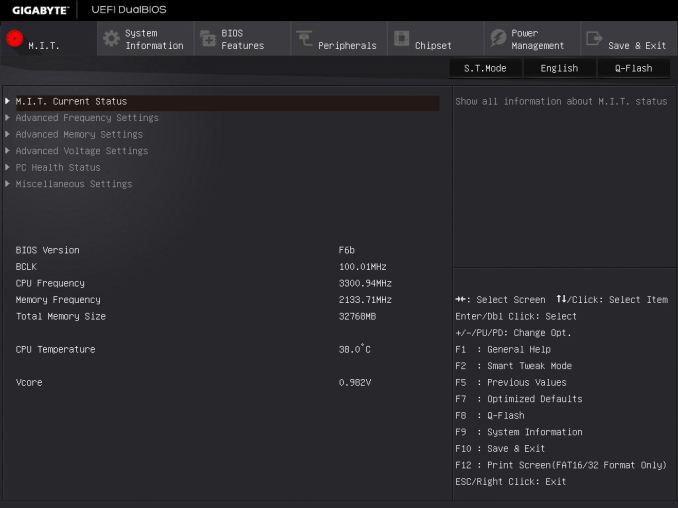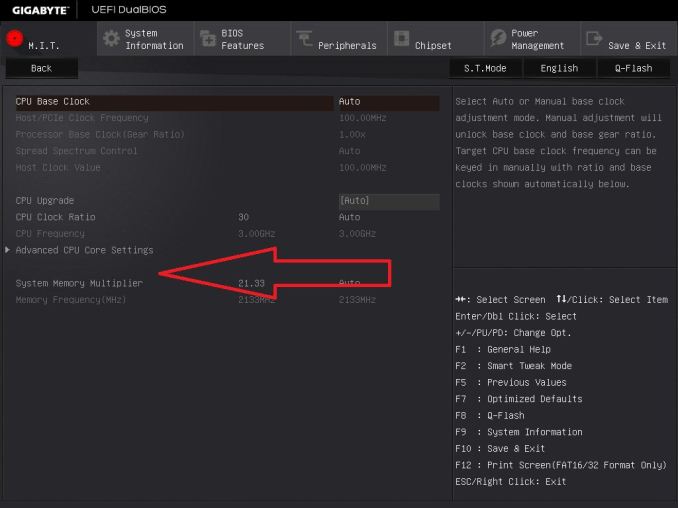DDR4 Haswell-E Scaling Review: 2133 to 3200 with G.Skill, Corsair, ADATA and Crucial
by Ian Cutress on February 5, 2015 10:10 AM ESTEnabling XMP
By default, memory should adhere to specifications set by JEDEC (formerly known as the Joint Electron Device Engineering Council). These specifications state what information should be stored in the memory EEPROM, such as manufacturer information, serial number, and other useful information. Part of this is the memory specifications for standard memory speedswhich a system will adhere to in the event of other information not being available. For DDR4, this means DDR4-2133 15-15-15 at 1.20 volts.
An XMP, or (Intel-developed) Extreme Memory Profile, is an additional set of values stored in the EEPROM which can be detected by SPD in the BIOS. Most DRAM has space for two additional SPD profiles, sometimes referred to as an ‘enthusiast’ and an ‘extreme’ profile; however most consumer oriented modules may only have one XMP profile. The XMP profile is typically the one advertised on the memory kit – if the capability of the memory deviates in any way from specified JEDEC timings, a manufacturer must use an XMP profile.
Thus it is important that the user enables such a profile! It is not plug and play!
As I have stated since reviewing memory, at big computing events and gaming LANs there are plenty of enthusiasts who boast about buying the best hardware for their system. If you ask what memory they are running, then actually probe the system (by using CPU-Z), more often than not the user after buying this expensive memory has not enabled XMP. It sounds like a joke story, but this happened several times at my last iSeries LAN in the UK – people boasting about high performance memory, but because they did not enable it in the BIOS, were still running at DDR3-1333 MHz C9.
So enable XMP with your memory!
Here is how for most motherboards except the ASUS X99-Deluxe, which uses an onboard XMP switch:
Step 1: Enter the BIOS
This is typically done by pressing DEL or F2 during POST/startup. Users who have enabled fast booting under Windows 8 will have to use motherboard vendor software to enable ‘Go2BIOS’ or a similar feature.
Step 2: Enable XMP
Depending on your motherboard manufacturer, this will be different. I have taken images from the major four motherboard manufacturers to show where the setting is on some of the latest X99 motherboard models.
On any ASUS X99 board, the setting is on the EZ-Mode screen. Where it says ‘XMP’ on the left, click on this button and navigate to ‘Profile 1’:
If you do not get an EZ mode (some ROG boards go straight to advanced mode), then the option is under the AI Tweaker tab, in the AI Overclock Tuner option, or you can navigate back to EZ mode.
For ASRock motherboards, depending on which model you have, navigate to OC Tweaker and scroll down to the DRAM Timing Configuration. Adjust the ‘Load XMP Setting’ option to Profile 1.
For GIGABYTE motherboards, press F2 to switch to classic mode and navigate to the MIT tab. From here, select Advanced Frequency Settings.
In this menu will be an option to enable XMP where this arrow is pointing:
Finally on MSI motherboards, we get a button right next to the OC Genie in the BIOS to enable XMP:
I understand that setting XMP may seem trivial to most of AnandTech’s regular readers, however for completeness (and the lack of XMP being enabled at events it seems) I wanted to include this mini-guide. Of course different BIOS versions on different motherboards may have moved the options around a little – either head to enthusiast forums, or if it is a motherboard I have reviewed, I tend to post up all the screenshots of the BIOS I tested with as a guide.















120 Comments
View All Comments
JlHADJOE - Thursday, February 5, 2015 - link
Will be interesting to see another article like this when we have CPUs with integrated graphics and DDR4.OrphanageExplosion - Thursday, February 5, 2015 - link
"For any user interested in performance, memory speed is an important part of the equation when it comes to building your next system."Doesn't your article actually disprove your initial statement?
And surely your gaming benchmarks might make more sense if - once again - you actually tested CPU intensive titles as opposed to the titles you've tested? The GPU will barely touch your expensive DDR4, if at all.
The only scenario I can see DDR4 making a real difference will be in graphics work with AMD APUs, and even then we'll need to see really high-end, fast kits that should just about offer comparable bandwidth with the slowest GDDR5 to offer a literally game-changing improvement.
Sushisamurai - Thursday, February 5, 2015 - link
Errr... Memory speed did make a difference (small IMO) when it came to DDR3. This article tests if it holds true to DDR4 - however, without an iGPU the other tests don't really show a significant difference when price is factored in. I mean, sure, there's a difference, but not worth the price premium IMO.A future AMD comparison would be nice, when AMD decides to support DDR4... Otherwise, it was a nice article.
FlushedBubblyJock - Sunday, February 15, 2015 - link
That's called the "justify wasting my life to write this article, tag and hook and sinker line, plus the required tokus kissing to the kind manu's that handed over their top tier for some "free" advertising and getting out the word.It's not like the poor bleary eyed tester can say: " I didn't want to do this because one percent difference is just not worth it, my name is not K1ngP1n and I'm not getting 77 free personal jet flights this year to go screw around in nations all over the world.
vgobbo - Thursday, February 5, 2015 - link
I really enjoyed this review!But... Intel processors are massive cache beasts, which reduces a lot the pressure put on memory (except for games, which I believe was the most interesting part of this review). Said that, I wish to see a review on an AMD system, which have a lot weaker cache structure and memory buses.
Is this possible to happen, or I'm just a dreamer? ;D
Anyway, this was another outstanding review of Anandtech! Loved it! Thank u guys!
dazelord - Thursday, February 5, 2015 - link
Interesting, but isn't Haswell-E/X99 accessing the memory in 256bit mode using 4 dimms? I suspect the gains would be much more substantial in 128bit/ 2 dimm systems.willis936 - Thursday, February 5, 2015 - link
Good stuff but after seeing a fair bit of memory roundups in my time I think this mostly confirms what everyone has been thinking: DDR4 is incredibly underwhelming in the performance space. You not only get better bang for buck with DDR3 right now but comparable, if not better, performance in the high end kits.galta - Thursday, February 5, 2015 - link
You've got it wrong. Nobody goes for DDR4 because of the memory, it's because of the new CPU and chipset.Ask yourself: do you really need extra cores and/or pci lanes? Or, do you want them and have the money to pay for it? If the answer is "yes" than you'll go for 5xxx and DDR4 is incidental.
Otherwise, go 4xxx and DDR3 will also be incidental.
It makes no sense to talk about memory as if it could be chosen independently from CPU/chipset.
rmh26 - Thursday, February 5, 2015 - link
Ian could you post more information about the NPB fluid dynamics benchmark. Specifically which benchmark CG, EP, FT ... and which class problem S, W, A, ...etc. In my own research I have found the simulation time to scale nearly linearly with the memory frequency for large enough problems. I am wondering how much the cache has to do with masking the effects of memory frequency on performance. As a the size of the problem gets larger the cache will no longer be able to mask the slowness of the memory. In general memory, and moreover interconnects between computers play a very important role in some HPC applications the rely on solving partial differential equations. In fact there have been suggestions to move away from the standard HPC Linpack benchmark used to create the top 500 lists as this compute intensive benchmark does not accurately reflect the load placed on supercomputers.http://insidehpc.com/2013/07/replacing-linpack-jac...
Dasa2 - Thursday, February 5, 2015 - link
Congrats anandtech you screwed up another ram review further misleading peopleThe games you chose to review are so badly GPU bottlenecked its sad. Do you not know that ram performance affects cpu performance?
You could run Dirt 3 with a i3 2100 vs a 5ghz 5960x and get the same score
How about putting some different CPU in amongst your ram benchmarks like 4460-4690 5820-5960x so people can see how faster ram compares to spending more on the CPU...
A 4690k with 1600c11 ram can perform slower in games than a 2500k with 2133c9 ram